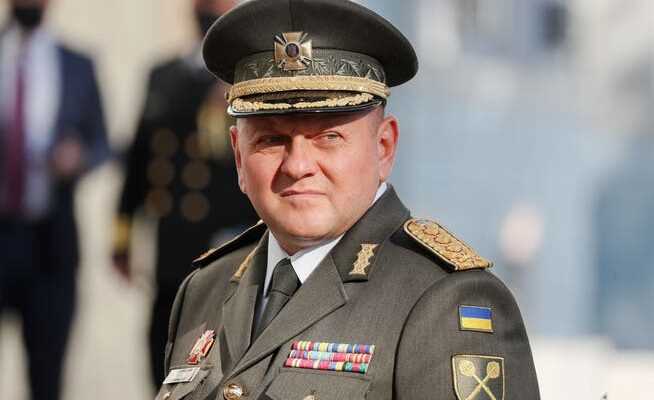Valery Zalushni has been in charge of the Ukrainian armed forces for just eight months. It represents an unmistakable departure from the military’s Soviet heritage – and thus contributes to Ukraine’s successful defensive struggle to date.
Valery Zalushni belongs to a new generation of Ukrainian officers.
If the Russian army leadership thought they had an easy time in Ukraine, then they should have listened to the supreme commander of the Ukrainian armed forces. Be prepared to receive the enemy said Valery Zalushni a month ago: “Not with flowers, but with anti-tank and anti-aircraft missiles.” And if Russia should attack after all? “Welcome to hell,” said Saluschni curtly.
In the meantime it has become apparent that Saluschni has not exaggerated. The Russian advance is slower and more costly than many experts had assumed. The Russian superiority in the air and the numerical inferiority of the Ukrainian ground forces were good prerequisites for a quick victory for Russia.
At 48, Saluschni is relatively young for a commander-in-chief. President Volodymyr Zelenskiy only appointed the father of two to Ukraine’s highest officer last July. But Saluschni’s age is also his advantage: he is the first Ukrainian commander-in-chief who was no longer trained in the Soviet Union. It symbolizes the far-reaching reform of the Ukrainian military since 2014.
The legacy of the Soviet Union took revenge in Crimea
When Valeri Zalushni finished school in the small town of Novohrad-Wolinski west of Kyiv in 1989, Ukraine was still part of the Soviet Union. During this time of upheaval, he followed in the footsteps of his father, who also belonged to the military. He attended the prestigious military academy in Odessa and graduated with honors from officer training in the ground forces in 1997.
During Zalushni’s time at the military academy, the young Ukrainian army was still heavily influenced by Russia. Until 2014, many senior positions in Ukraine’s security apparatus were held by Russians who spent their entire careers in the Soviet Union, says Hans Petter Midttun, who was Norway’s military attaché in Kyiv between 2014 and 2018. Their loyalty to Ukraine and their willingness to change were accordingly limited.
When Russia annexed Crimea in 2014, the impact of the Soviet legacy on the Ukrainian army’s combat effectiveness became apparent. The command structure was highly centralized based on the Soviet model: Since no orders came from Kyiv, the Ukrainian ground troops surrendered without a fight, while others even went over to the Russians.
A new Ukrainian army
As of 2014, Zalushni served almost non-stop in the embattled Donetsk region. When he was promoted to major general in 2017, he was in no hurry to be withdrawn from the eastern Ukrainian front, reports Radio FreeEurope. Saluschni is someone who not only fights on paper, but also in the field. A Ukrainian officer told the radio station.
Since the annexation of Crimea, the Ukrainian military has changed a lot. The US have over 3 billion dollars spent on equipping and training the armed forces. In addition, cooperation with NATO was intensified. Altogether, NATO officers trained 10,000 Ukrainian soldiers; the Soviet way of thinking lost importance.
Zalushni was one of the main advocates of Ukraine joining NATO and contributed to the interoperability of the military with NATO troops. As head of combat training, he promoted the use of western weapon systems and frequently conducted joint exercises with the British and American armed forces.
Before the invasion, Ukraine had 170,000 soldiers and 100,000 reservists and veterans. As a result of the war in eastern Ukraine, many units are battle-hardened. The mentality of the troops has changed completely since 2014. These are the most important factors for the current success of Ukraine’s defensive struggle, says former military attaché Midttun.
Change arrives at the military leadership
In order for the renewal to reach the top of the army, however, Saluschni had to be appointed. His predecessor, Ruslan Chomchak, had been educated in the Soviet Union, and former Defense Minister Andri Taran was known for having a Soviet-influenced style. Contrary to NATO requirements, Taran was not a civilian, but a former lieutenant general, and also tried to influence operational matters of the military.
The situation was made worse by the fact that Khomchak and Taran quarreled publicly. In November, President Zelensky appointed a new defense minister, Olexi Reznikov, with whom Zalushni works well.
The change was overdue because the Russian troops had already begun to deploy at the border. “Until then, Ukraine had a completely dysfunctional command structure,” says Sarah Whitmore, a lecturer in political science at Britain’s Oxford Brookes University.
Without Zalushni, the war would look different
Ukraine’s military reforms began well before Zalushni’s appointment as supreme commander last summer. But he is driving the changes more vigorously than his predecessors. The general is also battle-hardened himself and understands the problems faced by officers and soldiers who have been at war for eight years.
Saluschni also hammers in his own pegs operationally. One of his first official acts was to give officers in the field more autonomy so that a situation like that in Crimea in 2014 does not repeat itself. He ordered that the soldiers at the front could return fire without consulting the top command.
President Zelensky is de jure the supreme commander-in-chief, but he has no previous military experience. In order to wage the war, he is dependent on Zalushni. With him, Selenski made an excellent personnel decision, says Whitmore: “I don’t want to imagine what the war would look like now if Ukraine still had the team from last July at the head of the military.”
